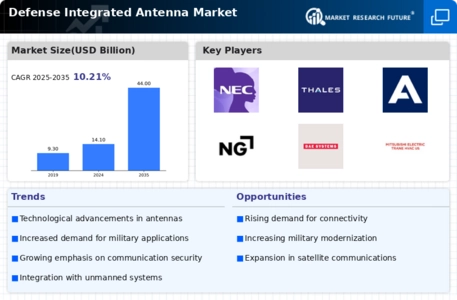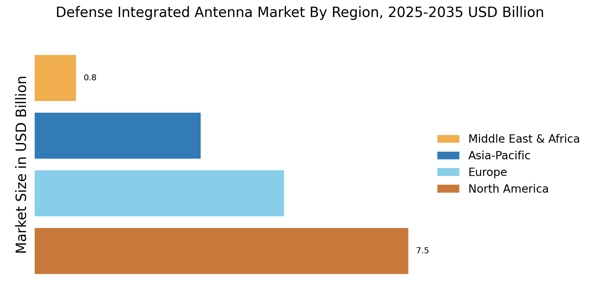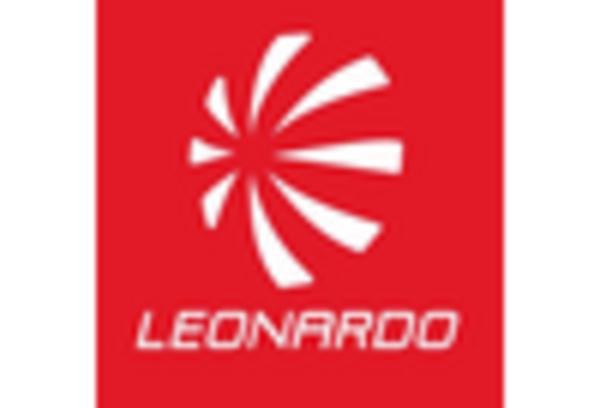Focus on Miniaturization and Portability
The trend towards miniaturization and portability is reshaping the Defense Integrated Antenna Market. As military forces seek to enhance operational efficiency, there is a growing emphasis on developing compact and lightweight antenna systems. These systems are crucial for mobile units that require effective communication without the burden of heavy equipment. The market for portable antennas is anticipated to grow significantly, with estimates suggesting a rise of 7% annually over the next few years. This shift towards smaller, more efficient designs not only improves mobility but also allows for easier integration into various platforms, including drones and portable communication devices. As a result, manufacturers are investing in research and development to create innovative solutions that align with this trend, thereby influencing the overall landscape of the Defense Integrated Antenna Market.
Rising Geopolitical Tensions and Defense Spending
Rising geopolitical tensions across various regions are driving increased defense spending, which in turn fuels the growth of the Defense Integrated Antenna Market. Nations are prioritizing the modernization of their military capabilities, leading to substantial investments in advanced communication technologies. This trend is evident in the defense budgets of several countries, which have seen an uptick in allocations for research and development of integrated antenna systems. The market is expected to benefit from this heightened focus on defense readiness, with projections indicating a potential increase in market size by 5% annually. As countries seek to enhance their strategic capabilities, the demand for sophisticated antenna solutions that support secure and reliable communication will likely continue to rise, further propelling the Defense Integrated Antenna Market.
Increased Demand for Connectivity in Defense Operations
The demand for enhanced connectivity in defense operations is a significant driver for the Defense Integrated Antenna Market. As military operations become increasingly reliant on real-time data and communication, the need for robust and reliable antenna systems has intensified. This demand is reflected in the projected market growth, which is expected to reach USD 3 billion by 2027. The integration of advanced antenna systems facilitates seamless communication across various platforms, including land, air, and naval forces. Furthermore, the rise of unmanned systems and satellite communications has created a pressing need for antennas that can operate effectively in diverse environments. Consequently, manufacturers are focusing on developing integrated solutions that meet these connectivity requirements, thereby shaping the future of the Defense Integrated Antenna Market.
Integration of Artificial Intelligence in Antenna Systems
The integration of artificial intelligence (AI) into antenna systems is emerging as a transformative driver within the Defense Integrated Antenna Market. AI technologies are being utilized to optimize antenna performance, enhance signal processing, and improve overall system efficiency. This integration allows for adaptive communication systems that can respond to dynamic operational environments, thereby increasing the effectiveness of military operations. The market is projected to see a growth rate of approximately 8% as defense organizations increasingly adopt AI-driven solutions. This trend not only enhances the capabilities of existing antenna systems but also paves the way for the development of next-generation technologies that can revolutionize communication in defense applications. As AI continues to evolve, its impact on the Defense Integrated Antenna Market is likely to be profound, driving innovation and operational excellence.
Technological Advancements in Defense Integrated Antenna Market
The Defense Integrated Antenna Market is experiencing a surge in technological advancements, which are pivotal in enhancing communication capabilities. Innovations such as phased array antennas and multi-band systems are being integrated into defense applications, allowing for improved performance in various operational environments. The market is projected to grow at a compound annual growth rate of approximately 6.5% over the next five years, driven by the need for advanced communication systems in military operations. These advancements not only improve signal quality but also enhance the ability to operate in contested environments, making them essential for modern defense strategies. As nations invest in next-generation technologies, the Defense Integrated Antenna Market is likely to witness increased competition among manufacturers, further propelling innovation and development.


















Leave a Comment